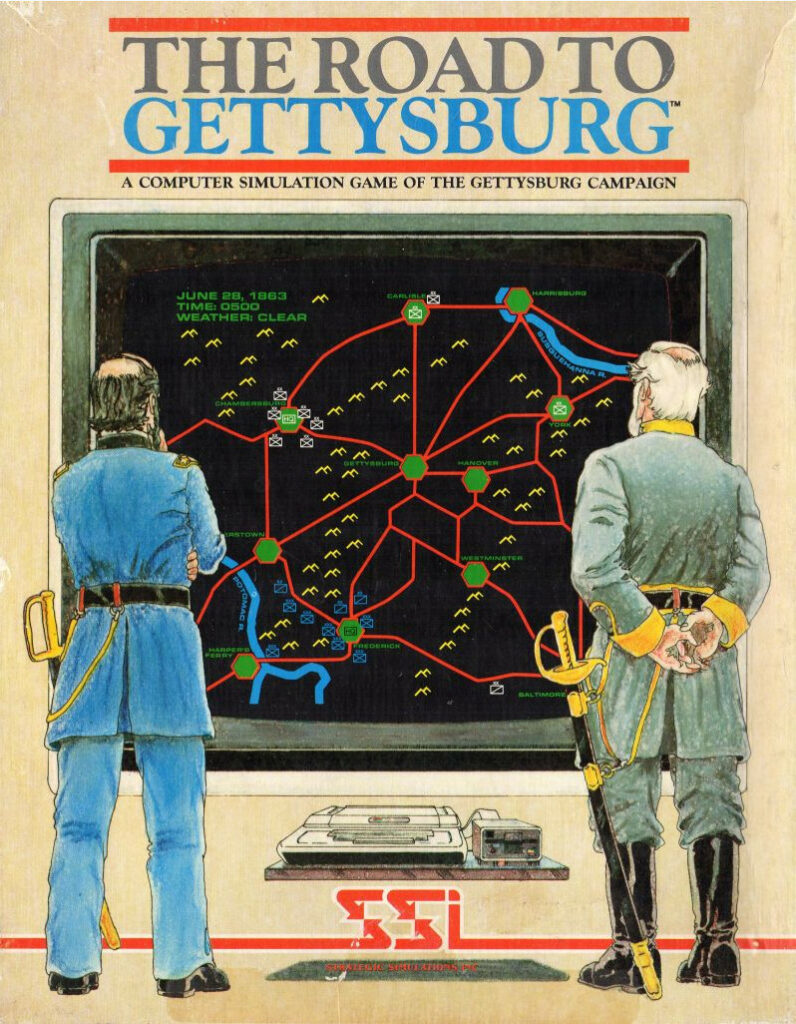
Lieutenant Narwhal, you will not be able to simply apply what you learned during your Napoleonic Campaigns to dominate the US Civil War.
I know! The technology has evolved: railroad, telegraph, breech-loading rifles, …
Don’t forget the most important innovation: reconnaissance reports!
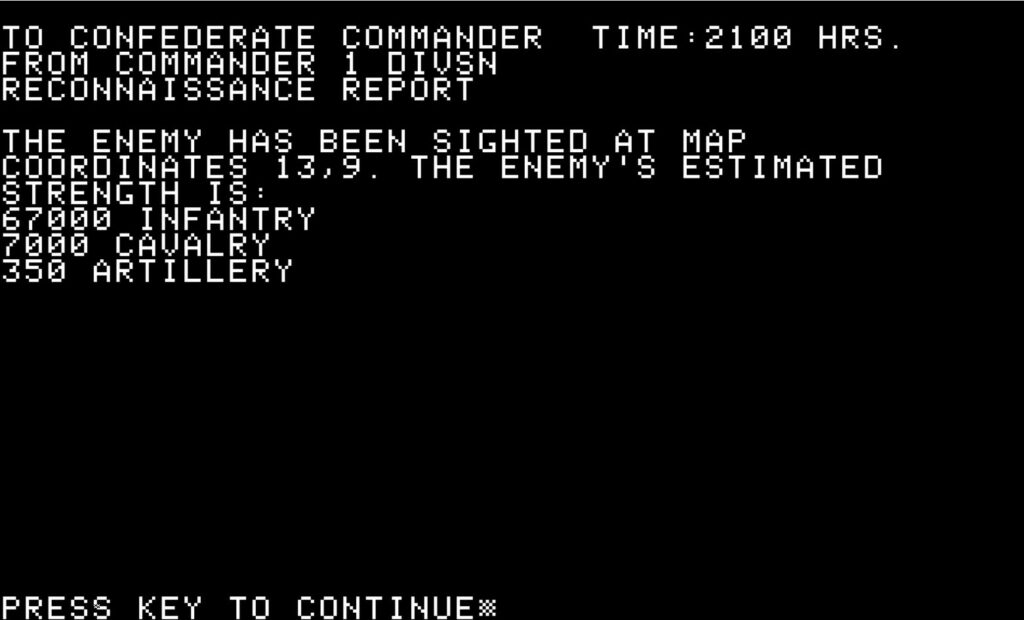
Released by SSI in 1982 at the same time as Pursuit of the Graf Spee, Paul Murray’s The Road to Gettysburg uses the same engine as Napoleon’s Campaigns – the two games were even sometimes reviewed together. As you may remember, I had a terrible experience in Napoleon’s Campaigns, because all the versions circulating on Internet have an issue with reconnaissance totally missing from the game [edit 29/01/2025: Actually they don’t, more info here]. Luckily, that’s not the case in The Road to Gettysburg.
Predictably, the Road to Gettysburg comes only with one battle: the battle of Gettysburg, which I don’t need to introduce. Suffice to say that it is widely considered the turning point of the Civil War, as it was the last chance for the Confederacy to force the Union to sign a peace treaty. In the game, there are two possible set-ups: a long scenario starting on the 28th of June 1863 and ending on the 4th of July 1863, and a focus on the battle of Gettysburg itself (July 1st to July 3rd). In solitaire, it is only playable as the Confederacy.
Before I start this AAR, a note. The “in-game” display is just as lacklustre as it was in Napoleon’s Campaigns, but the game box includes a map and counters, so I will use a combination of pictures of the map, and map directly edited. In addition to this, my version of the Road to Gettysburg came with the counters unpunched, and I did not have the heart to punch them, so I used counters from Napoleon’s Campaigns. Hence, in the pictures on my board the Confederates will be using green counters.
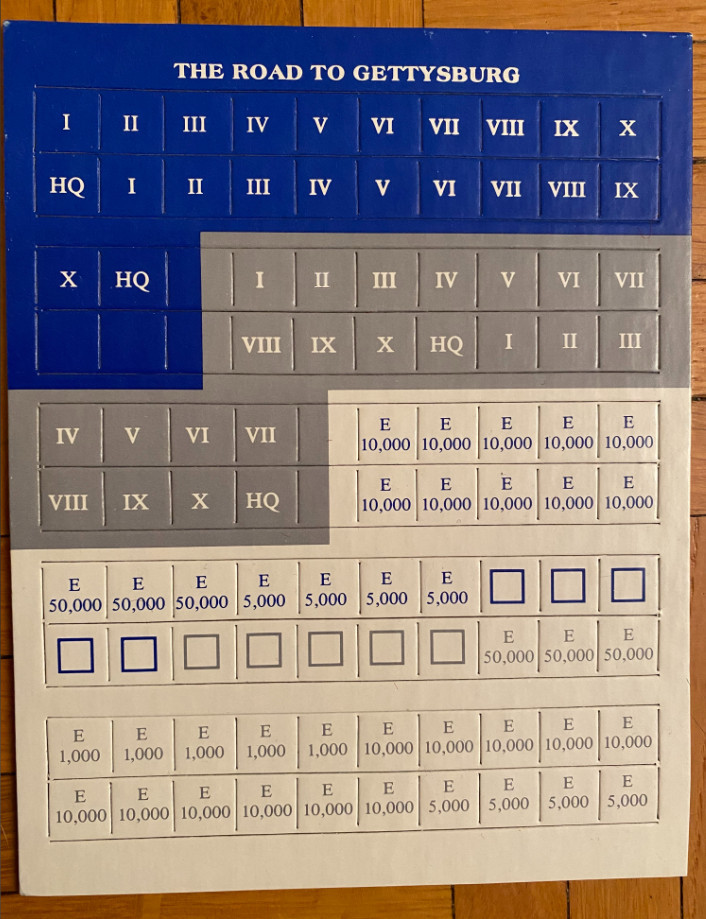
28th of June, 5 AM
On the morning of the 28th of June 1863, Meade’s [Union] Army of the Potomac deployed around the city of Frederick while Lee’s [Confederate] Army of Northern Virginia is deployed mostly around Chambersburg, with some divisions more than one day of march away. In particular, the Confederate cavalry, Stuart’s division, is very far away from the rest of the army – historically its absence will have a major impact on the battle.
The objective of the Confederates is to exit as many units toward Washington in the southeast of the map. For extra victory points, divisions can “forage” on any tile they stop on, with cities and roads offering more foraging capacity than regular tiles.
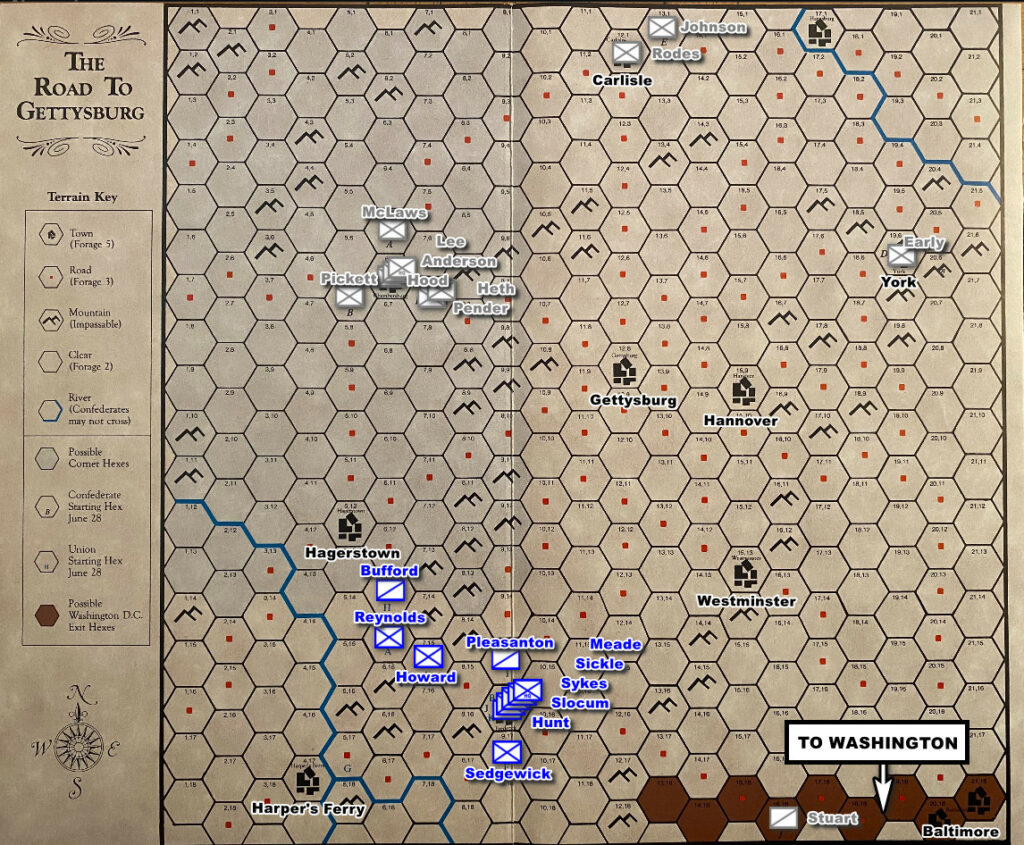
The strategy is to move East, as fast as possible with the main force, while Stuart, Johnson, Early and Rodes will meet up with the rest of the force in Hannover (in order to avoid cluttering the road: units can stack, but there can be only one unit moving per tile at any moment). Then I will avoid major combat, only fighting to hold the Northerners while I pass the second mountain range and turn South toward Washington.
28th of June, 5 PM
My troops have marched in a conga line for a full day. Four more hours of marching, and then they’ll stop for the night.

This is what I see on my screen :
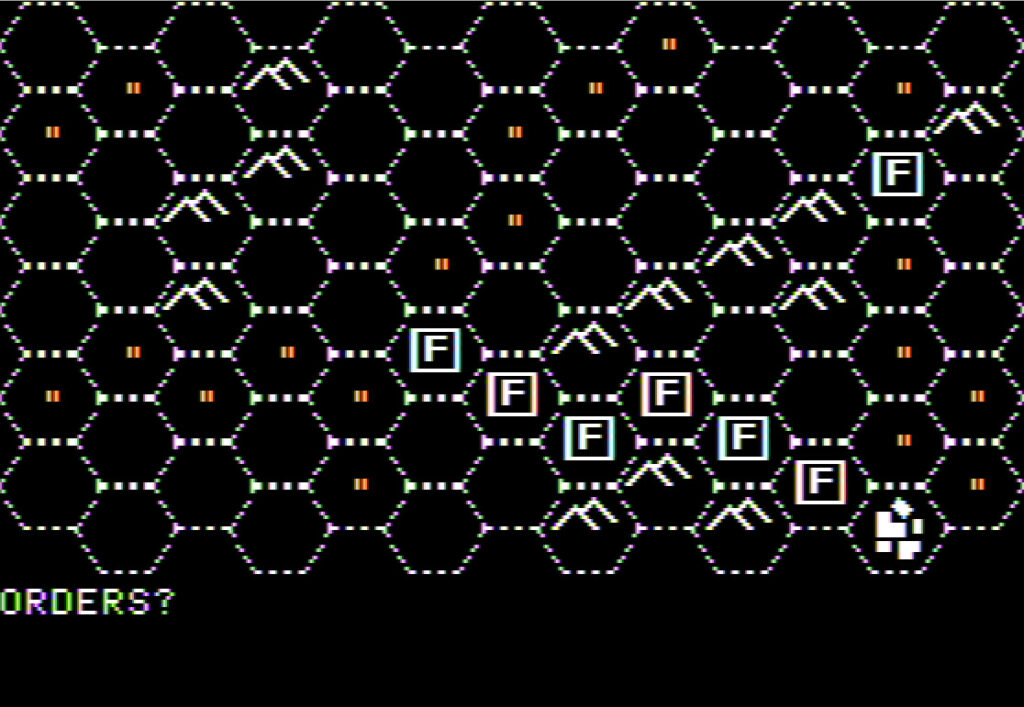
29th of June, 5 AM
I wake up to a surprise, and a realization that I made a newbie mistake: I did not force march into Gettysburg, and during the night Union cavalry occupied it!
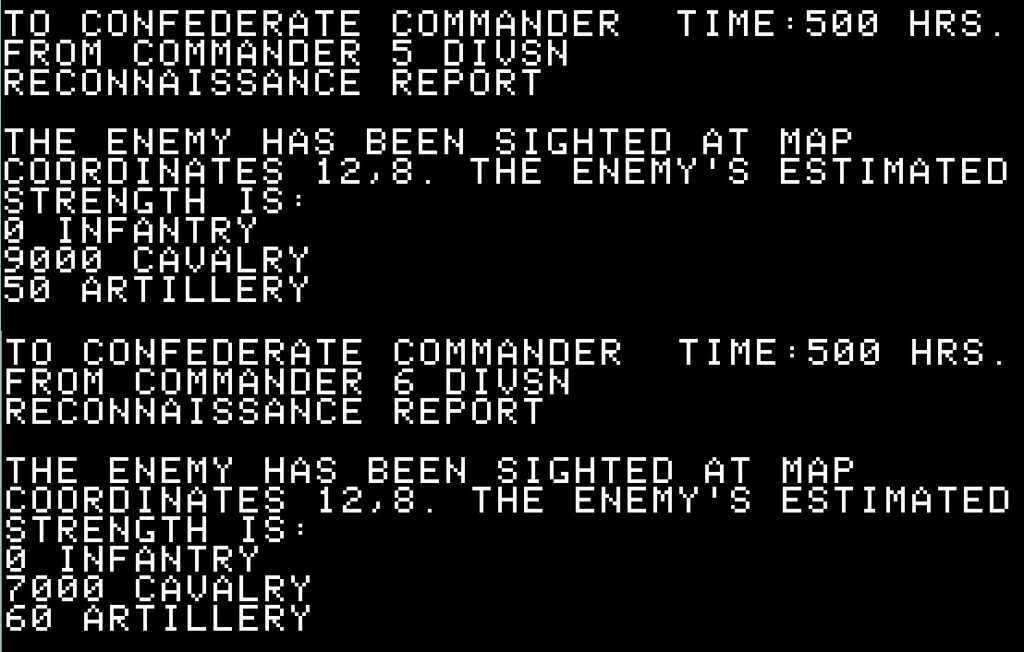
Another cavalry force is detected by my rear guard, it has to be Buford’s, so 3 000 horses. A lot of movement is seen South of Gettysburg as well.
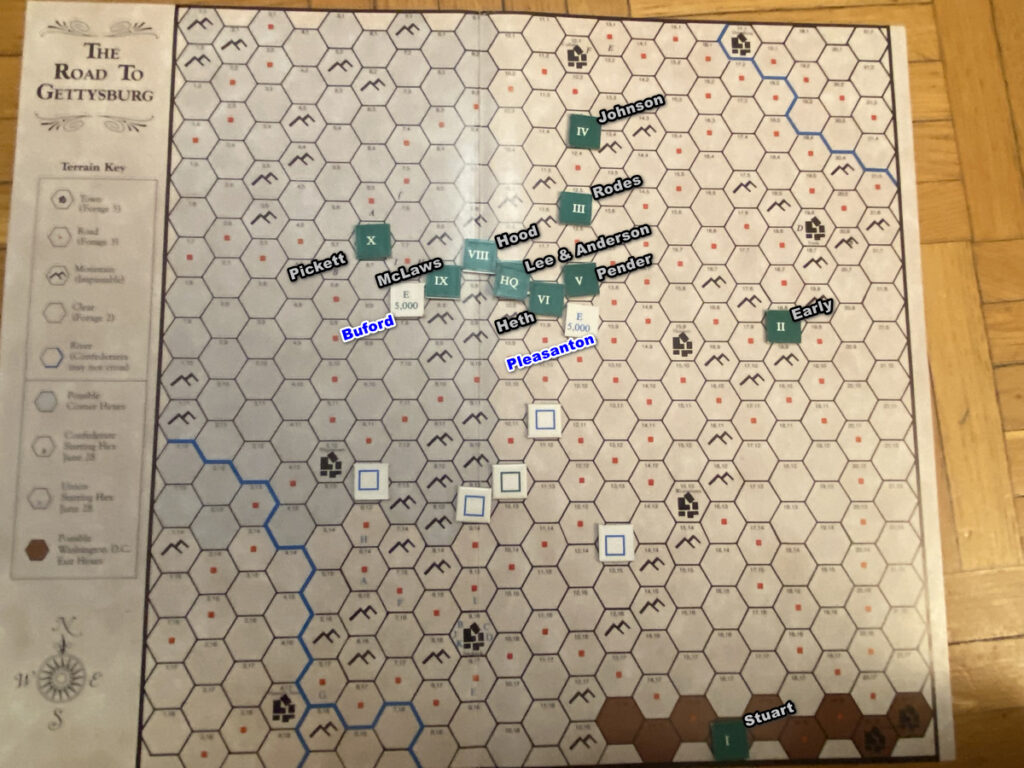
The problem is that units refuse to move as long as they are in contact with enemy forces. There is an easy solution though: for now I am only against reconnaissance cavalry – I can easily attack it and hopefully chase it.
29th of June, 1 PM
Pender’s, Anderson’s and Heth’s divisions attacked the enemy cavalry at Gettysburg, under Lee’s personal supervision. It was an easy engagement, and I am now occupying Gettysburg!

McLaws is also chasing the cavalry harassing the rear.
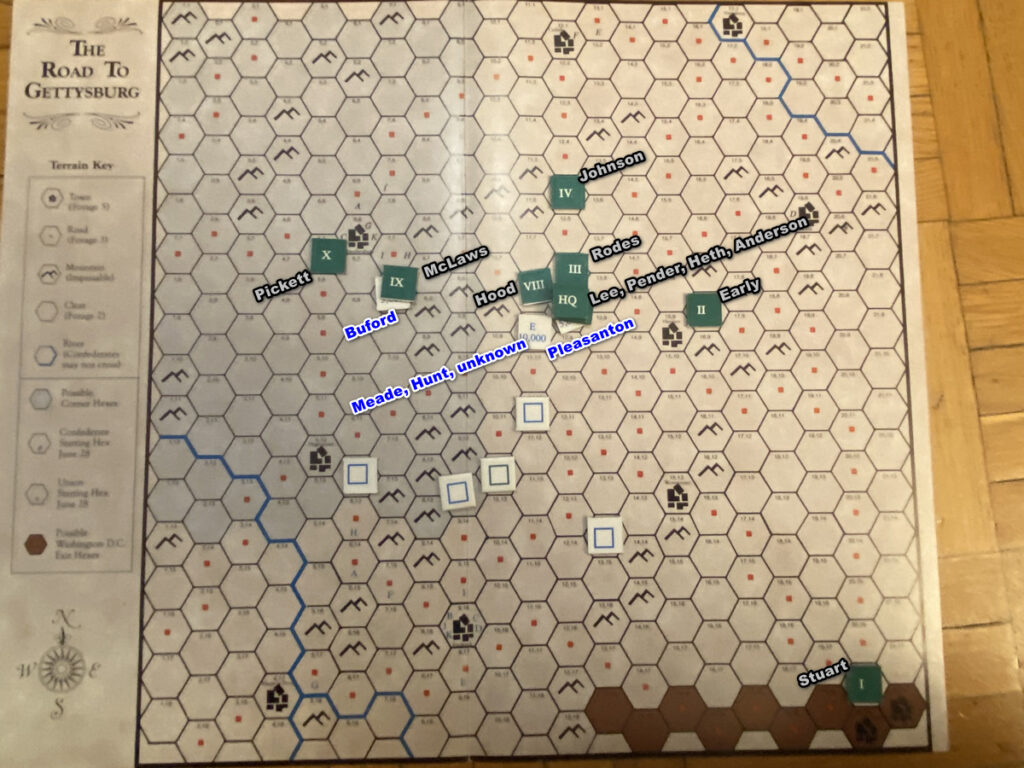
South of Gettysburg, I detect a large infantry corps with a LOT of artillery.

Still, I have 20 000 men and counting gathered in Gettysburg, and I have a decisive advantage in a city against cavalry. I will destroy the cavalry, and the infantry too if it dares attack, then I will pull back and continue on my merry way to Washington.
29th of June, 9 PM
The plan worked well so far, and I caused significant damage to the Union as my troops converged toward Gettysburg faster than theirs :
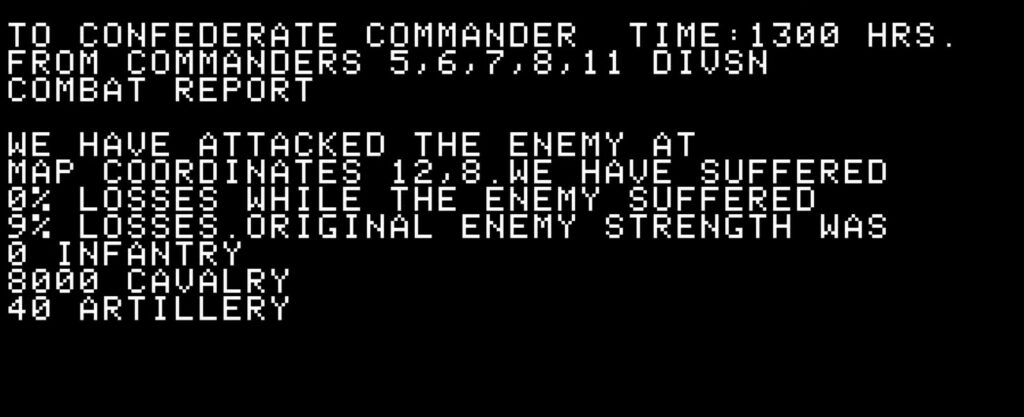
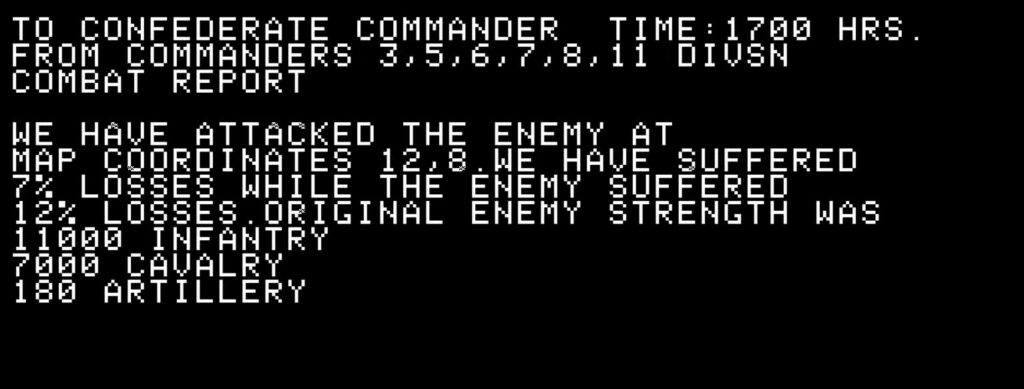
Similarly, in the west, McLaws badly mauls the Union cavalry, while Pickett does not do anything useful.
No combat during the night, maybe it will be time to bail out from Gettysburg in the morning.
30th of June, 9 AM
In the morning the situation gets a bit scary :
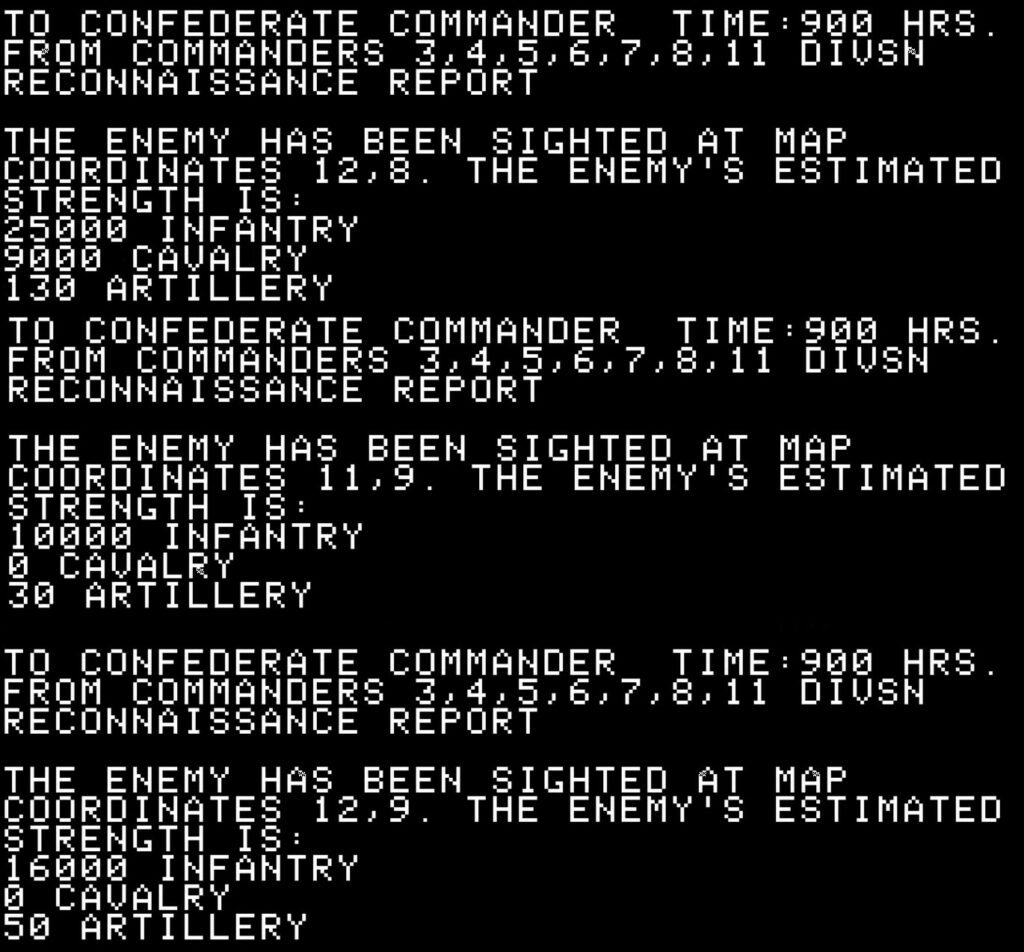
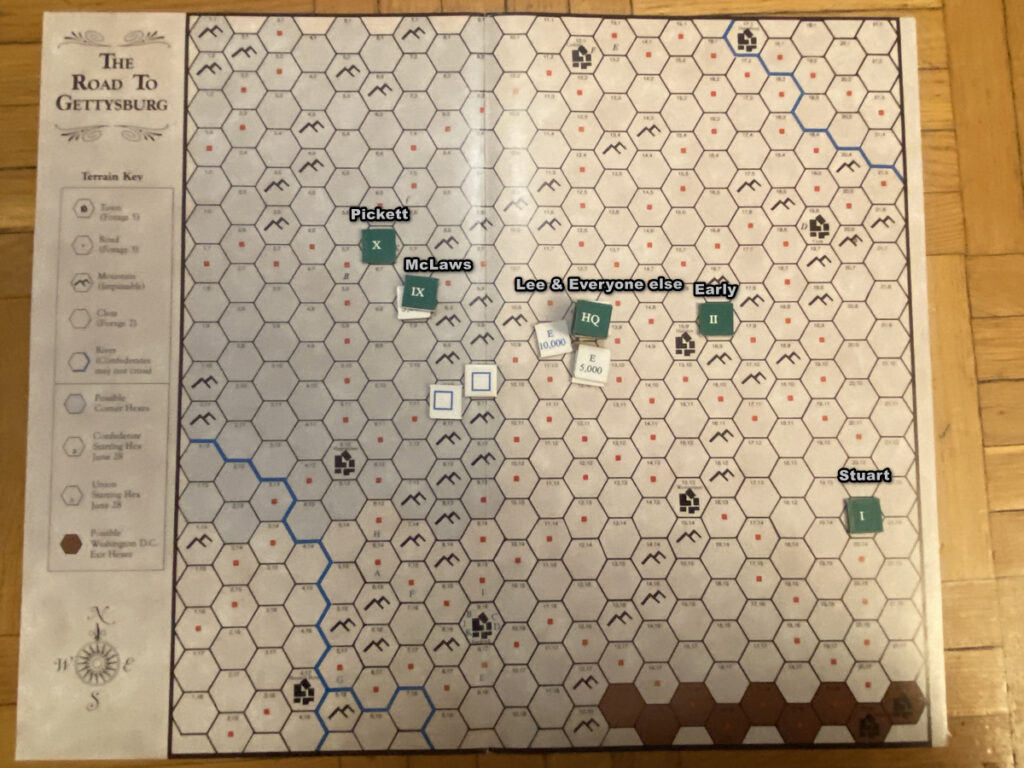
I prepare to bail out, leaving only Heth’s division behind to cover the retreat. The rest is given the order to withdraw to the North-East of Gettysburg. Hopefully, Heth’s division will not have to hold for long as I am also calling Early’s division – which I had kept in reserve – to replace it when possible.
Pickett is also requested to come to Gettysburg. Clearly, the man needs close supervision if I want to get some use out of him.
30th of June, 5 PM
The Union attacks around 1 PM, just as I was withdrawing.

I stayed a bit too long than I could and should have (I could easily have left as early as 9 in the morning) and I am now paying the price: in the confusion of battle my divisions did not all withdraw where I wanted to, and my forces are split between those which retreated North and those which retreated East!
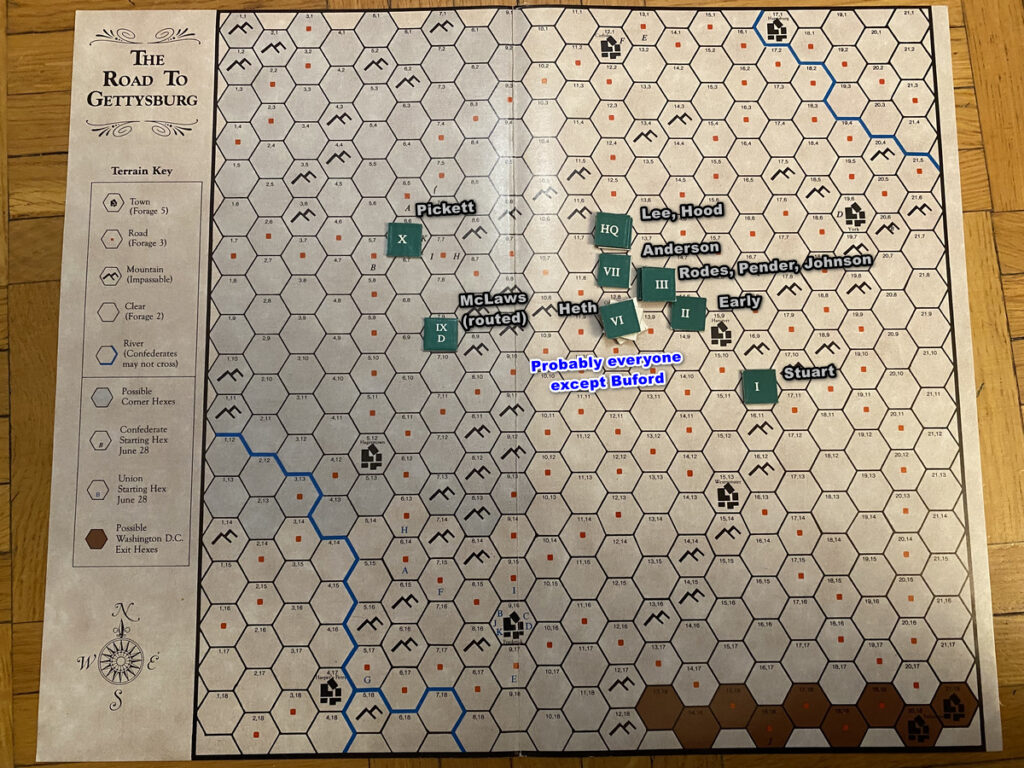
In addition to this, I had received a few hours later an unexpected memo from McLaws explaining that he had routed somehow, but without any report of combat. Most probable cause: he decided to march during the night, and in doing so accumulated so much fatigue that his army routed.

1st of July, 5 AM
I manage to extricate myself from the situation of Gettysburg: Early’s division arrived at 9 PM the previous day, just as Heth’s division was routed. Unable to move due to Early’s division, but unable to attack due to the night, the Union was held in place (or more specifically, in Early’s hexagon) while the rest of my army recovered from fatigue and reorganized.
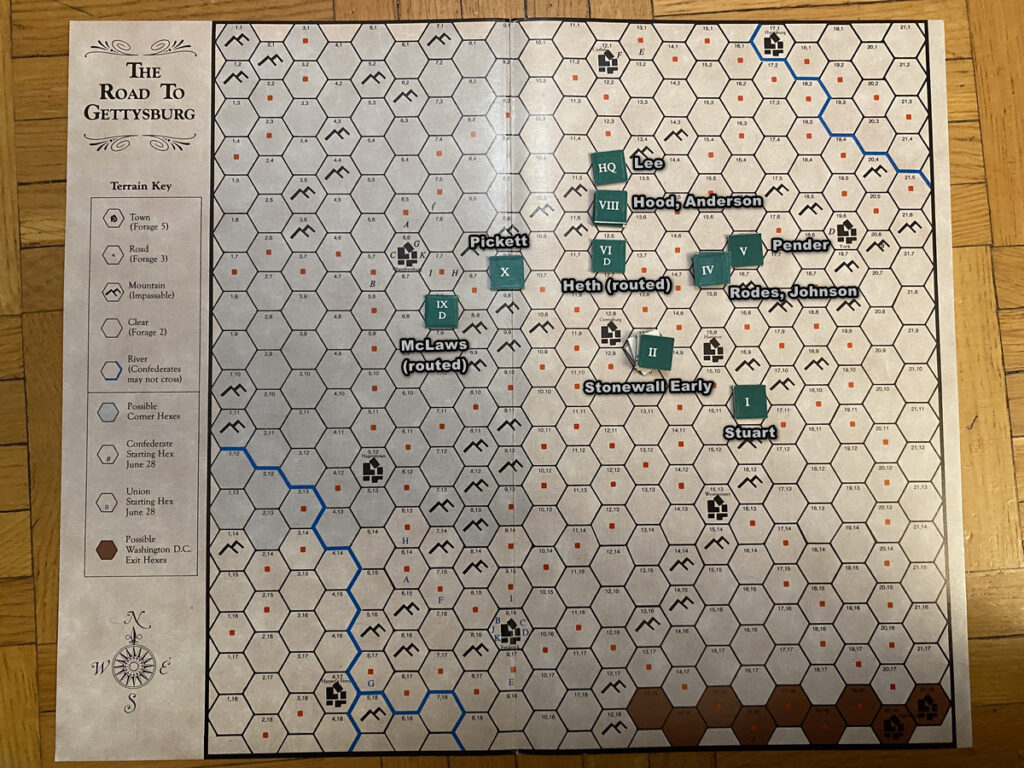
My objective is still to march to Washington, with Heth and later Pickett pinning the Union.
1st of July, 5 PM
I told Early to hold, and boy is he holding – despite being outnumbered 10-to-1 and suffering 15% loss every turn (4 hours). Meanwhile, my forces are escaping!

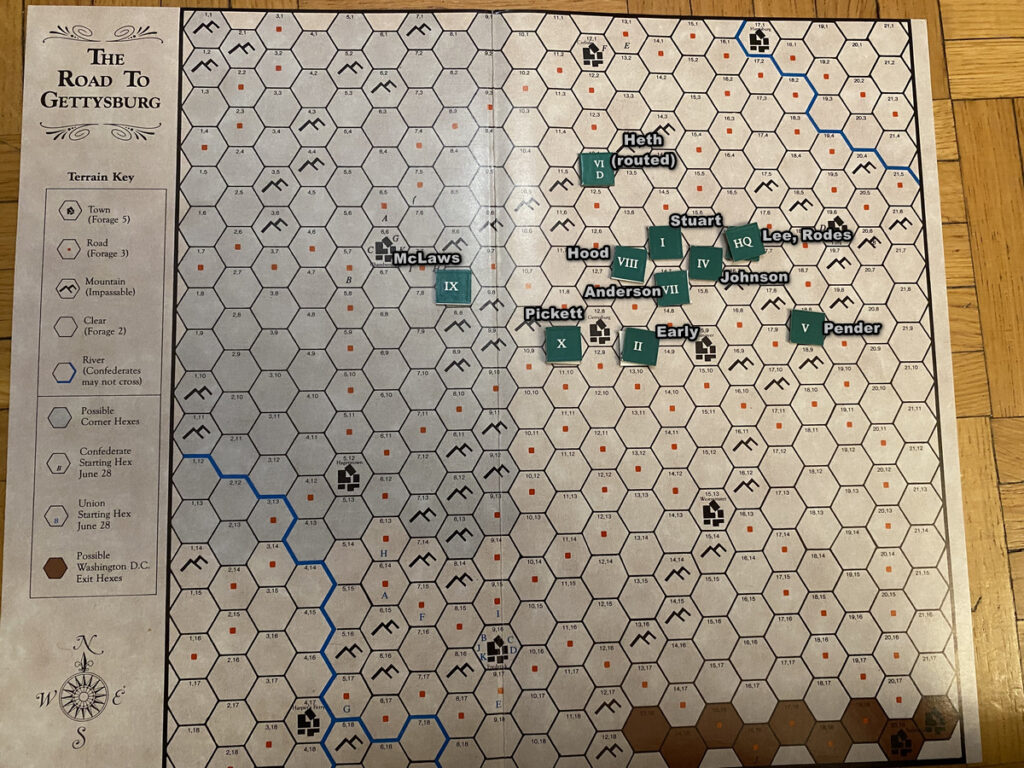
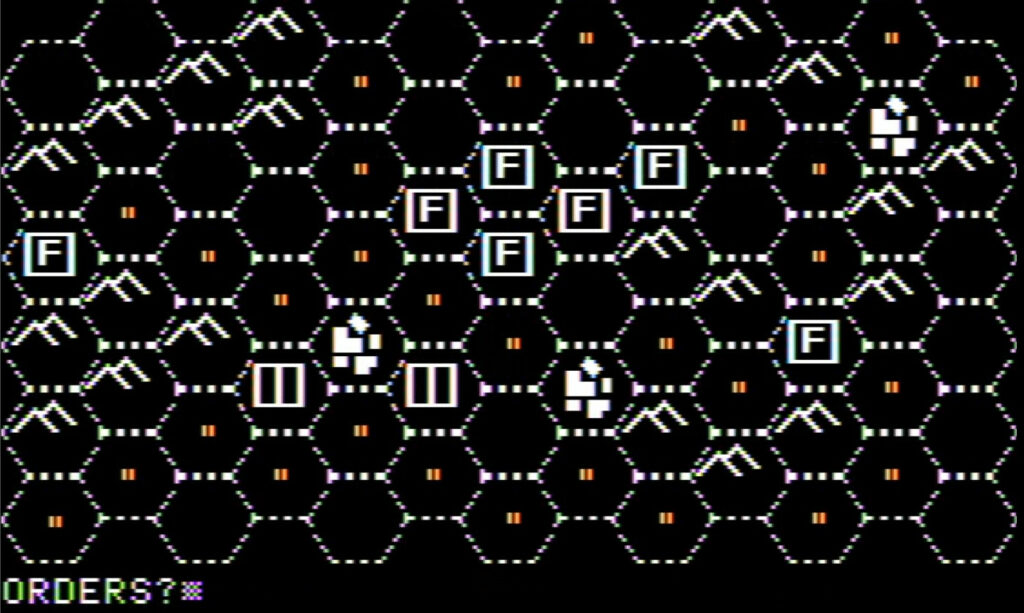
Meanwhile, Pickett is coming from the West and catches survivors from the Buford’s Cavalry Division, pretty much routing them. Honestly, I can’t credit Pickett for that, McLaws did all the work on that part of Union Cavalry.
2st July, 5 AM
I was informed late yesterday of the total destruction of Early’s division. They held to the last, Battle of Camerone Alamo style. Their sacrifice was not in vain – they saved the Army of West Virginia from annihilation.

Some of the Union Cavalry, in pursuit, managed to make contact with some of my forces. The rest is unable to pursue because before it can move it is “pinned” by Pickett’s 5000 or so men, finally useful for once. Hood will attack the cavalry, so Anderson can withdraw further East!
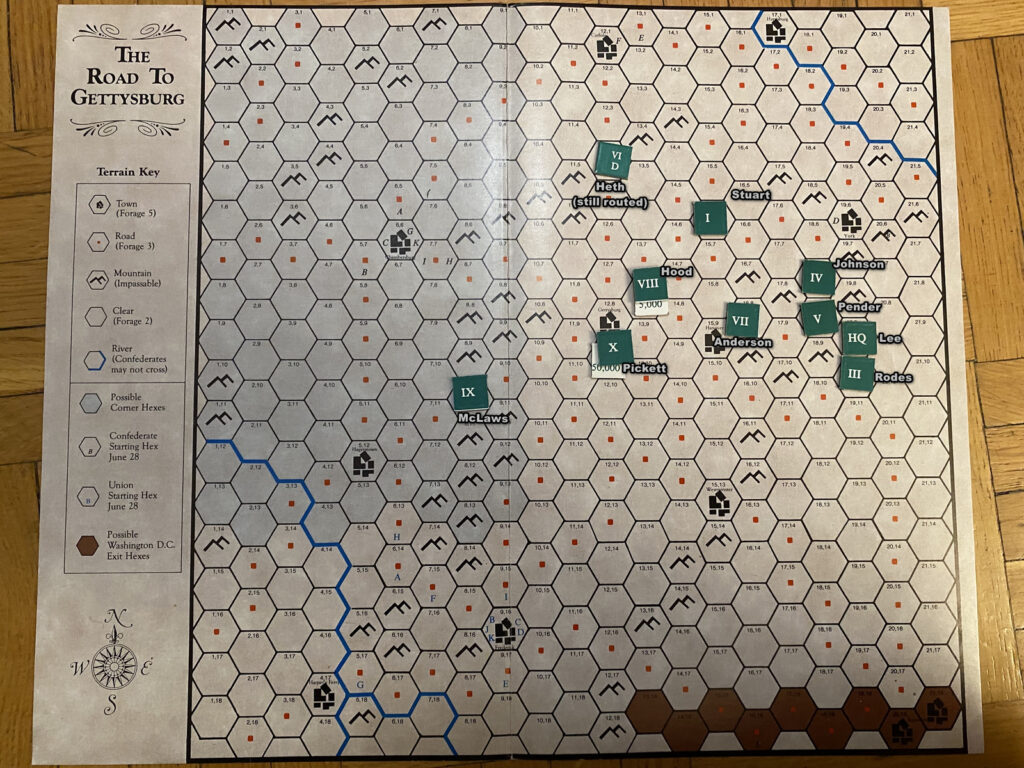
2nd of July, 9 PM
As my headquarters move further and further away from Gettysburg, I receive more and more distant reports. What I know is that Pickett has finally annihilated Buford’s cavalry corps, just before being engaged around 5 by the rest of the Yankees, minus the second Union Cavalry corp engaged by Hood. Anderson’s division withdrew, East as expected.
3rd of July, 9 PM
Not much happened during the first half of the day.
It starts pouring the second half of the day, slowing down movement tremendously and halting most combat. I still receive, with a lot of delays, a bitter report from Pickett that “he has no more division“. Maybe, but tomorrow we will be marching on Washington, Pickett. I made you part of the greater History, Pickett! What did you want? Some sort of glorious charge? There is more honour in a well-led defensive action, trust me.
I order the report to be destroyed.

Hood manages to use the rain and the night to withdraw safely from combat.
4th of July, 9 PM
Between the rain and the general exhaustion, absolutely nothing happens on the 4th. I do not manage to exit my army toward Washington. Well, maybe Pickett’s (and Hood’s) last stand was for nought.
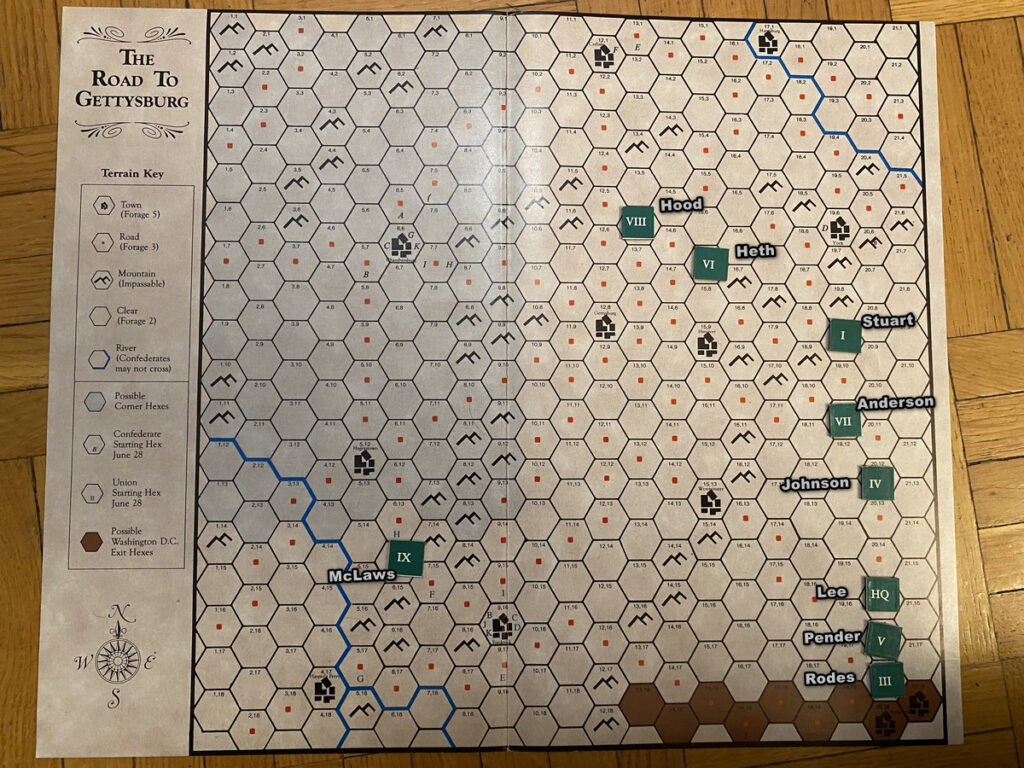
Final results
Here are the losses of the battle :
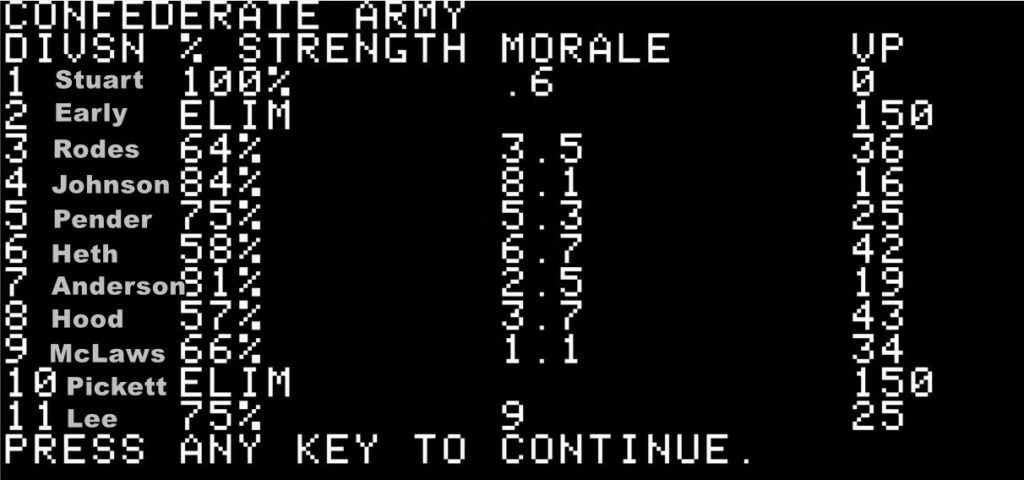
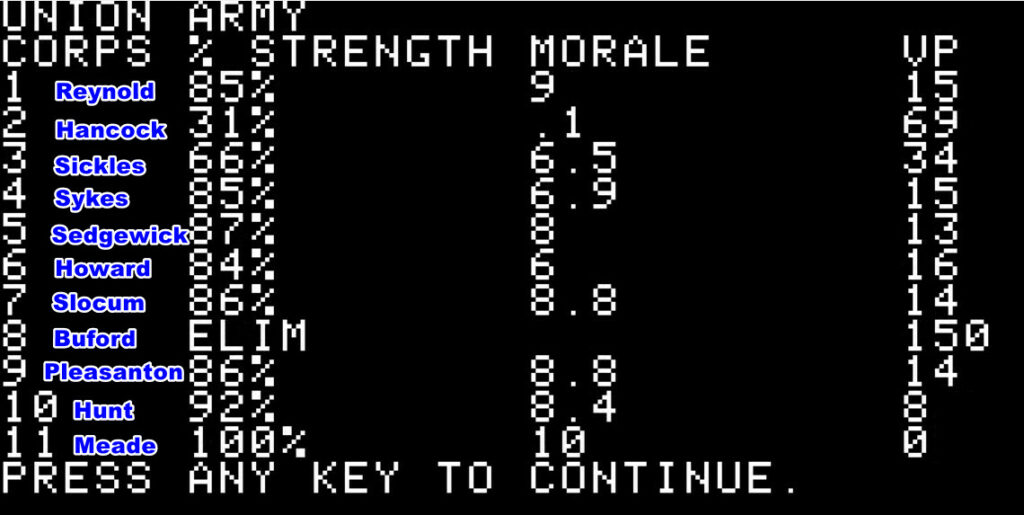
According to my calculation, the Confederates had 26 000 casualties out of 69 000 men (artillerymen excepted, as the game only displays the number of guns) while the Union had 25 000 casualties out of 94 000 men – almost historical results. The battle would have been even bloodier without the rain allowing me to disengage Hood’s division safely on the 3rd of July.
As for the points :

Overall, I made a few strategic blunders, in particular not occupying Gettysburg, letting myself get drawn into a massive battle there, and not disengaging early enough on the 30th of June. I am pretty happy with how well my withdrawal went after that, but it was supposed to be Lee against the Union, not Washington against the British.
I would like to thank lurker Senex for sending me The Road to Gettysburg’s game box from the United States , right after sending me the one for Napoleon’s Campaigns. The manuals were not really documented, so I would not have been able to play either game without him.
Rating & Review
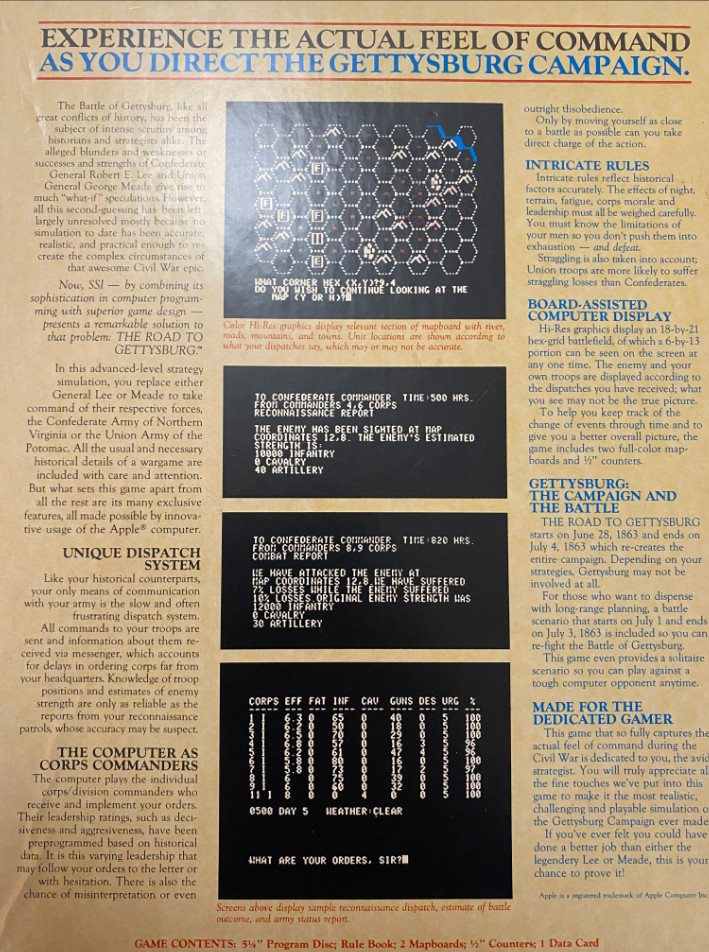
The Road to Gettysburg by Paul Murray, published by SSI, USA
First release: March 1982 on Apple II
Tested on: Apple emulator
Total Hours Tested: 8 hours
Average duration of a battle: 2 hours
Complexity: Brutal (5/5)
Would recommend to a modern player :No
Would recommend to a designer: No
Final Rating: Obsolete [Edit 29/01/2025: In 2024 I updated my rating system, which moved Road to Gettysburg to one star]
Napoleon’s Campaigns: 1813, 1815 had been a commercial failure (2872 copies would be sold in total), but for SSI this did not mean a game about operations (rather than strategy or tactics) was a bad idea. If the concept could work, then it had to work with the ever-popular battle of Gettysburg. If not, well, the next SSI in-house game would be about something else entirely.
There was not much to do to adapt the game, by Joel Billings’ admission to contemporary reviewers, the two games were 90% similar, though Murray used the opportunity to fix some bugs and change some rules. Similarly, the content of the box of The Road to Gettysburg is in every way similar to Napoleon’s Campaign :
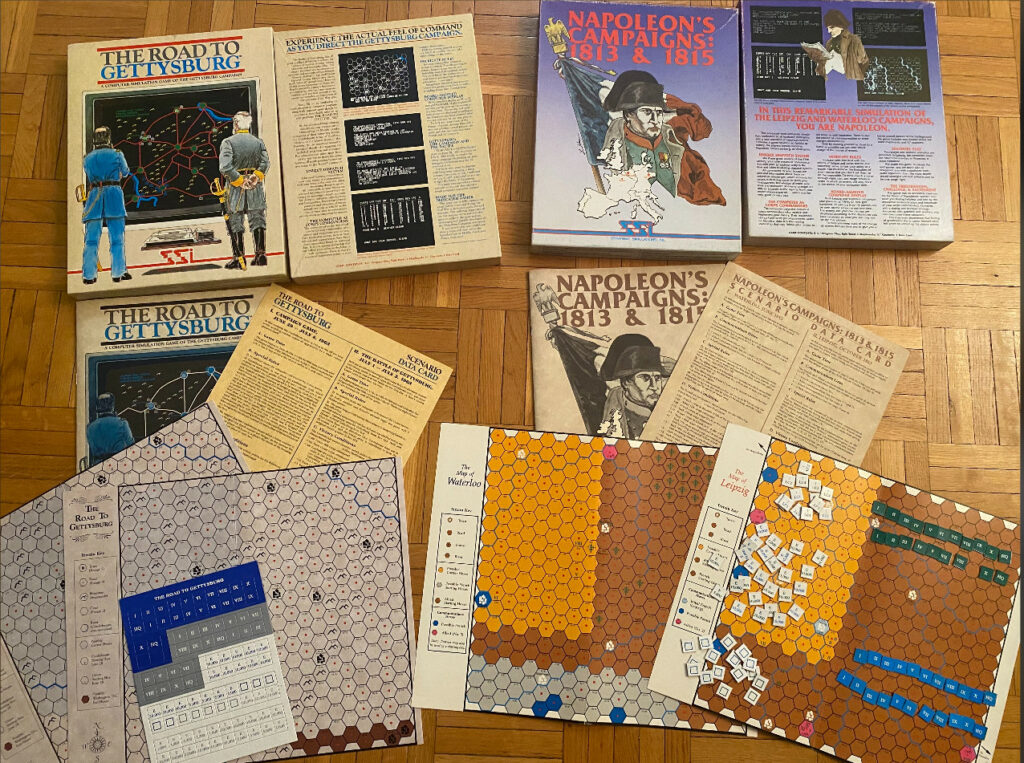
- One manual,
- One reference card with the scenarios on one side and the command on the other,
- Two maps, even though there is only one battle (with one long and one short scenario) in TRTG,
- Exactly 100 counters,
- And of course, the exact same price: $59.95,
The games were so similar that most of the hermetic manual of Napoleon’s Campaigns was copied – I even found a mention of “forests” in TRTG, even though these had been replaced, as impassable terrain, by mountains.
Beyond the fact that I did not have the “reconnaissance bug”, there are a few rule modifications that change significantly how the game is played, and in my opinion, enhance tremendously the player experience. I will come back to that, but first :
A. Immersion
Just like Napoleon’s Campaigns, The Road to Gettysburg is one of the very few games that accurately represents the difficulty of commanding troops with slow communication and incomplete if not outright incorrect information. It includes commanders with different “personalities” (sadly only represented by aggressiveness, this is not an AGEOD game yet). TRTG removed lines of communication (which felt contrived and were unrealistic in behaviour anyway) and added foraging (for VP calculation only) but also the concept of “stragglers” – soldiers that are left behind when a unit marches, especially at night, and that will join back slowly over time; this does not have much impact in-game, but it adds some chrome. Overall, the game feels realistic, except for those mega-stack combats.
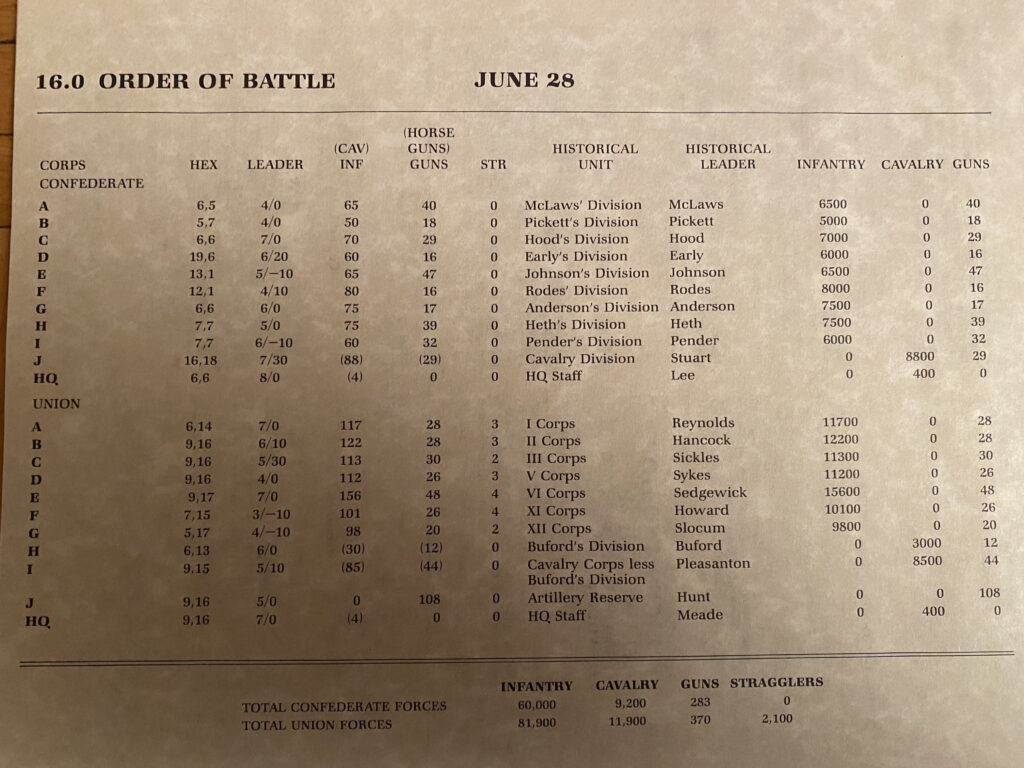
Sure, the game is not pretty, but after all Lee and Meade did not have a nice screen to fight it out either.
Rating : Quite good
B. UI , Clarity of rules and outcomes
Let’s get that out of the way: Napoleon’s Campaigns had the worst manual I ever read, and reading The Road to Gettysburg was even worse because I had to find the small differences in a manual otherwise mostly similar. After 14 hours of playing the ruleset, I still don’t understand what a “secondary commander” is.
The great news is that as I stated above the Lines of Communication (LOC) were removed. These were needlessly complex (in the Battle of Waterloo, the allies had 1 different LOC for each nationality – 3 in total) and poorly feedbacked (once set up, they were not recalled anywhere in the game, and there was no way to know whether a line of communication was cut or not), even worse they made the use of “forces” organized around the HQ frustrating since all parts of the force had to be on the LOC.
Most of the other frustrating issues of Napoleon’s Campaigns are still there though. In particular:
- Control on speed is based on “urgency”: a unit with high urgency will force march everywhere you want it to go and a unit with low urgency will make sure it is never fatigued by not moving at all. The problem is that urgency doubles down as “aggressiveness if you engage in combat”, when really it should be two different settings. It also means that if your army that you forced march to the destination is engaged in combat, it will go all-in, even though it is probably exhausted. Due to this, you keep micro-managing the urgency of your units.
- On high urgency, units will march themselves into exhaustion… and rout even without combat. I believe this is what happened to McLaws’s division in my AAR,
Still, The Road to Gettysburg is way more manageable than its predecessor… after you have invested hours and hours in the system learning its quirks.
Rating : Very poor
C. Systems
Let’s start with the most important difference between the two games. It took me several frustrating hours to find it, as I was trying to understand why some of my divisions were not moving.
It is hidden in one sentence of the manual, after a part explaining a unit cannot enter a hex containing another unit moving, except if preparing for combat :
- Napoleon’s Campaigns: “7.2. A corps may always enter a hex containing a friendly [Army HQ].”
- The Road to Gettysburg: “7.2. Army HQ units may always stack with friendly units and do not block friendly units from entering their hex.”
Subtle, isn’t it? This sentence is one of the very few differences between the two manuals that is not an addition or the removal of a rule, and it changes everything :
- In Napoleon’s Campaigns you can move huge stacks, provided Napoleon or Wellington are there,
- In The Road to Gettysburg, you cannot, only your Army HQ can stack during movement,
While this rule has a historical basis it also makes the game miles more interesting! In Napoleon’s Campaign, you did not care much about positioning, you just stacked as much as you could and moved to your target. This is not only due to the reconnaissance issue in my version, even in his AAR in Computer Gaming World Joel Billings pushed mega-stacks around. In The Road to Gettysburg, your forces are going to be either disseminated or slow to move, and you need to pay a lot more attention to how you move, which is just as well because combats are (still) lacklustre.
Combats work exactly as they did in Napoleon’s Campaign, though due to the nature of Civil War they are simpler: there were 19 factors in Napoleon’s Campaigns, there are only 13 in The Road to Gettysburg (including a flat bonus for Confederates). In addition to this, units are either full infantry or full cavalry. It makes combat a lot more predictable: in general numbers will prevail, but the Confederates have an advantage, and so has cavalry, but not in cities.
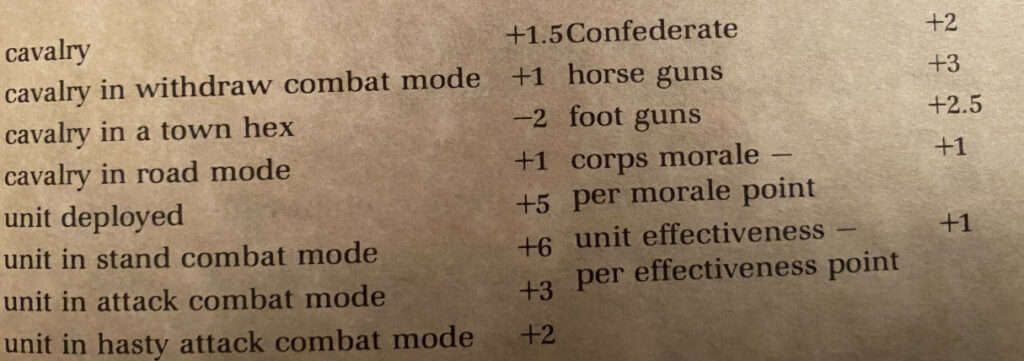
And what if you don’t want to fight? Well, that’s the part I had not understood in Napoleon’s Campaigns. A unit next to a hostile force cannot march normally. The only way to leave is to transition to “withdraw mode” But withdrawal is very risky, particularly for fatigued units, as a failed withdrawal can cost up to 30% of the starting force’s strength. In addition, the withdrawing unit can be followed, so it is important to have some units to pin whatever the first unit was withdrawing from, or to withdraw at night. This makes The Road to Gettysburg one of the very few games where it is important to keep a reserve, rather than going all-in: a fresh reserve can easily hold off a much more powerful force while the rest of the army regroups, reorganizes or rests.
For a game about coordinating distant forces across a small region rather than just on a battlefield, the game lacks tools to coordinate units not in range of the Commander-in-Chief. I already covered the stiff “urgency system” (which should have been split between “speed” and “aggressiveness”), but there is no way to have your divisions coordinate when afar (they don’t coordinate their march speeds or their attacks but instead always act as if they were the only division at their location). The only way to avoid your “distant” divisions not to either always attack, always stand or always withdraw at the sight of any enemy is to give them the “initiative” order, but you cannot give more details depending on what they face (“only attack if you are sure of victory”, “attack with low urgency to pin”, …). Maybe The Road to Gettysburg also played better than its predecessor because all combats happened in the central region, “in range” of the C-i-C’s micromanagement.
Rating: Quite good
D. Scenario design & Balancing
There are two scenarios in the game, and the short one is only the battle itself, with not much manoeuvring possible.
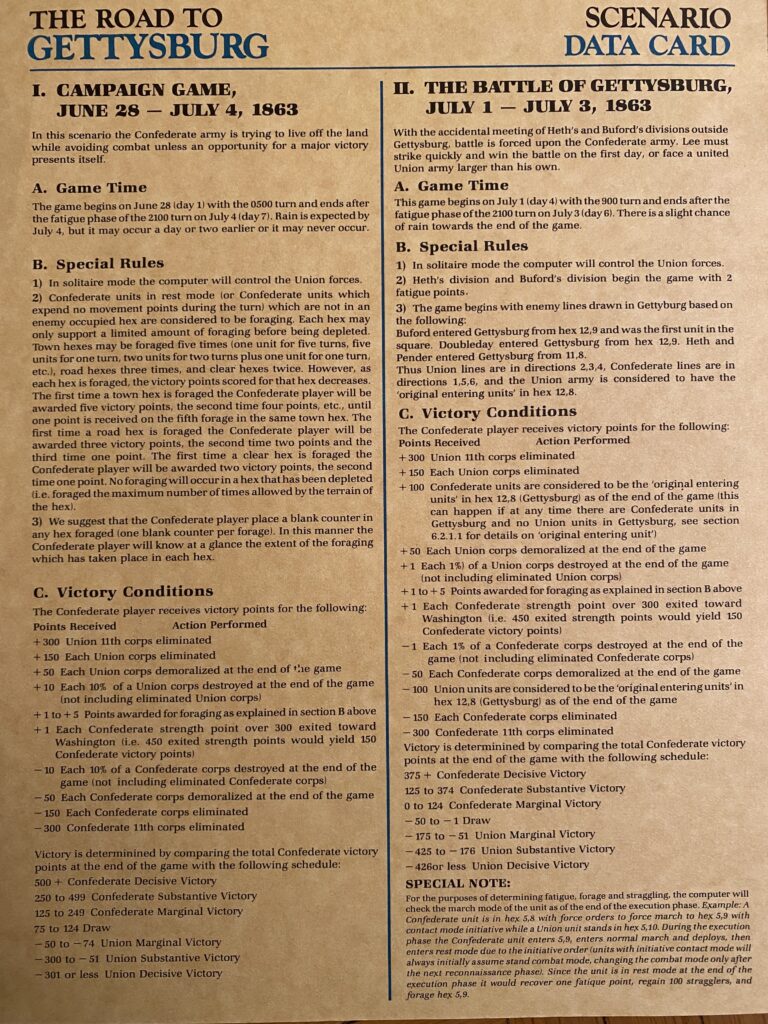
Even the larger scenario does not have the strategic freedom of Napoleon’s Campaign, where Corps (both allied and hostiles) and objectives were all over the place. Instead, the Union starts grouped, there is only one route to the exit area and, in my numerous tests before I understood why my units were not moving, I found out that the Union AI always uses the same strategy: larger cavalry straight to Gettysburg, smaller one toward Chambersburg, and once in contact form a mega-stack before attacking. It works, at least at difficulty 3 out of 4 at which I am playing, but only because of the massive Union numerical advantage.
Rating : Very poor
E. Did I make interesting decisions?
Yes, every turn, but only after investing hours to understand the game, and by then the 1.5 scenarios offered had grown stale.
F. Final rating
Obsolete.
In my conclusion to Napoleon’s Campaign‘s review, I stated I was looking forward The Road to Gettysburg. I was not disappointed, and the latter made me realize that, without the scouting issue, Napoleon’s Campaigns would have a lot more to offer than I initially thought; I will for sure try to confirm this impression when I put my hands on a fixed version.
Nonetheless, The Road to Gettysburg is obsolete, not due to its game rules that are impressive for 1982, but due to the incredibly steep learning curve and because even when you finally understand the game, you still need to fight against a poorly designed UI every single turn.
Contemporary Reviews
As popular as the topic is, The Road to Gettysburg generated few reviews, with those reviews focusing on how complex (both in a good and a bad way) the game is.
I already mentioned the double-review of Napoleon’s Campaigns and The Road to Gettysburg by Archibald Dale in Creative Computing (August 1982), praising the game but (under)stating “the instructions could use a bit more explanations in some areas”. But even Bob Proctor in Computer Gaming World (September 1982), usually SSI’s biggest fan and ready to tackle games like Torpedo Fire, punches without gloves: “To the three sources of fog [of war] listed above, SSI has added a fourth. They have done almost nothing to help someone just getting started to figure out what’s happening. The first game (…) is a bewildering experience. Why doesn’t unit A move when ordered? Why haven’t I heard from unit B? Why am I suffering twice as many casualties as the enemy when I have them outnumbered.” He also complains (like I did since Napoleon’s Campaigns) about urgency being both “speed of movement” and “aggressiveness in combat”. Still, “if you want the best that’s available, TRTG it is“. Finally, Family Computing in December 1983 calls the command control system “sometimes frustrating”, warns the user that it will take a few run-throughs before the player can actually understand the game but that, after that, “The Road to Gettysburg is an excellent simulation of the great Campaign.”
The game sold particularly poorly, even less than Napoleon’s Campaigns: 2 181 copies. Meanwhile, the Warp Factor was on its way to sell 15 000 copies or so in total. For Joel Billings and his only full-time developer Paul Murray, the data was clear! The next in-house game would be set in space: The Cosmic Balance!